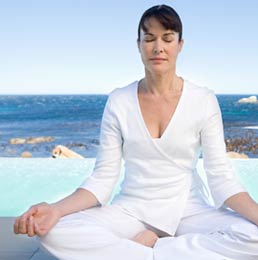
Guided imagery harnesses the power of imagination to induce relaxation and reduce stress. Preliminary research from Purdue University (Research in Nursing & Health, October 2006; Pain Management Nursing, September 2004) suggests that guided imagery may improve pain, mobility and the quality of life for people with osteoarthritis.
The technique is thought to work by tricking your body into responding to the soothing sensations as though they were the real things.
For instance, if you see yourself in your mind’s eye floating peacefully on a cloud, your body may actually relax, slowing your pulse and lowering your blood pressure. In addition, your body may release endorphins, chemicals that are natural painkillers.
One study by the Purdue researchers included 28 women over age 65 who had osteoarthritis pain. These women were randomly divided into an imagery group, which listened to a 12-minute guided imagery tape twice a day for 12 weeks, and a control group, which was included for comparison’s sake and didn’t take part in the guided imagery. The script for the tape was designed to promote relaxation and positive thoughts about reduced pain and improved mobility. It was filled with vivid imagery about beautiful sights, soothing sounds and comfortable feelings. The tape also led the women through a relaxation exercise in which they relaxed major muscle groups one after another, moving from the feet to the head.
By study’s end, the imagery group had improved its health-related quality of life, while the control group had not. Pain and mobility are big factors in quality of life, and a previous study by the same researchers suggested that guided imagery might help manage these osteoarthritis symptoms. However, even when questions about pain and mobility were excluded from a questionnaire used to measure quality of life, the imagery group still showed improvements. The remaining questions covered topics such as social activities, support from other people, tension and mood. This suggests that imagery exercises may help improve not only physical symptoms, but also social and emotional well-being.
Guided imagery is one of a group of mind-body techniques that focus on the interaction between mental and physical factors as they influence overall health and wellbeing. An underlying assumption of these techniques is that people with a variety of illnesses can play an active role in managing their disease.
Guided imagery can be learned and practiced on your own with the help of a tape or book. Imagery training is also offered by therapists and other health care providers. To find a qualified practitioner, ask your doctor, a local hospital or a wellness center for a referral. If you’re being treated for an emotional or mental disorder, talk to your therapist first before trying this approach.
Hundreds of studies have shown that guided imagery can help reduce stress and make life less difficult for people with a wide range of diseases. When you have osteoarthritis, possible benefits include less pain, fewer problems getting around and enhanced social and emotional coping. In short, guided imagery won’t make the disease disappear, but it may make the symptoms easier to live with.
PLEASE NOTE: The studies and their findings that are presented in this article are for informational purposes only and are not meant to take the place of the advice of your doctor. By providing you with this information, Sanofi is not endorsing its content nor does it represent that the information is necessarily appropriate for you. You should consult with your doctor before starting any new health or exercise regimen.
References“Alternative Treatments for Arthritis: An A to Z Guide.” D. Foltz-Gray. Atlanta, GA: Arthritis Foundation, 2005.
“Imagery.” American Cancer Society. Available at: http://www.cancer.org/Treatment/TreatmentsandSideEffects/ ComplementaryandAlternativeMedicine/MindBodyandSpirit/imagery. Accessed September 6, 2011.
“Effect of Guided Imagery with Relaxation on Health-Related Quality of Life in Older Women With Osteoarthritis.” C.L. Baird and L.P. Sands. Research in Nursing & Health. October 2006, vol. 29, no. 5, pp. 442–451.
“A Pilot Study of the Effectiveness of Guided Imagery with Progressive Muscle Relaxation to Reduce Chronic Pain and Mobility Difficulties of Osteoarthritis.” C.L. Baird and L. Sands. Pain Management Nursing. September 2004, vol. 5, no. 3, pp. 97–104.
“What is Complementary and Alternative Medicine?” National Center for Complementary and Alternative Medicine. Available at: http://nccam.nih.gov/health/whatiscam. Accessed September 6, 2011.